Please report any broken links or trouble you might come across to the Webmaster.
Please take a moment to let us know so that we can correct any problems and make your visit as enjoyable and as informative as possible.
| Click On Image For Full Size | Size | Image Description | Source | |
|---|---|---|---|---|
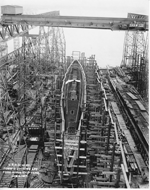 |
1.60k | Schley (SS-52) forward looking aft, 9 January 1917. Note the construction of two other submarines on the ways to the left. The only other submarines under construction at Fore River were O-3 (SS-64), O-4 (SS-65), O-5 (SS-66), & O-6 (SS-67), which were all laid down between 2 thru 8 December 1916. |
Photo & text i.d. courtesy of David Johnston US National Archives photo # 19lc 11 from NARA, College Park, Maryland, courtesy of Sean Hert. | |
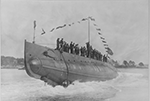 |
318k | Launching of the O-4 (SS-65), 20 October 1917. Note the boat's mushroom anchor can be clearly seen retracted into the hull in a break in the bilge keel, behind the torpedo tube bow cap and directly under the bow planes. This is a feature not normally seen with the boat in the water. These boats all had a standard fluke-type anchor housed in the superstructure on the starboard bow and this anchor was the one normally used for mooring out. The mushroom anchor could be used for this purpose, but its primary use was to allow the boat to "hover" while submerged. The boat would come to a complete stop, drop the mushroom anchor and then adjust ballast to achieve a slight positive buoyancy, drawing the anchor chain tight. It would then adjust its depth by paying out or heaving in on the anchor chain. This could be a very useful tactic when sitting off an enemy's harbor waiting for ships to come out. |
Text i.d. courtesy of David Johnston National Archives Identifier: 45547170 Local Identifier: 165-WW-499A-18. Photo courtesy of catalog.archives.gov | |
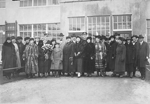 0806511 |
122k | O-4 (SS-65) was sponsored by Mrs. Henry Williams (Maud Steers), wife of Naval Constructor Henry Williams U. S. Navy,
Superintending Construction. She is pictured here as ship's Sponsor with her party at the destroyer Flusser's (DD-289) christening ceremonies, Squantum, Massachusetts, 7 November 1919. Mrs. Williams is standing toward the left, holding flowers. |
Text from Ships of the United States Navy and Their Sponsors, pg. 159 Photo NH 98007 courtesy of the history.navy.mil. Collection of the Society of Sponsors of the United States Navy. U.S. Naval History and Heritage Command Photograph. | |
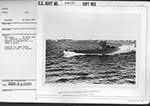 |
961k | 23 March 1918, the O-4 (SS-65) doing 14 knots off Provincetown. | USN photo # 80-G-466173 from NARA, College Park, Maryland, courtesy of Sean Hert. | |
 |
64k | O-4 (SS-65), in coastal waters with many of her crewmen on deck, circa 1918-1919. | USNHC photograph # NH 103181. Collection of Christopher H.W. Lloyd. Donated by Virginia Agostini, 1990. | |
 |
103k | O-4 (SS-65), in drydock at the Charleston Navy Yard, South Carolina, circa 1919. | USNHC photograph # NH 103185. Collection of Christopher H.W. Lloyd. Donated by Virginia Agostini, 1990. | |
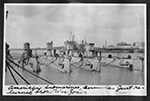 |
579k | U.S. submarines at Bermuda. Just returned from war zone. From left to right, 2 unidentified O-boats, O-3 (SS-64), O-5 (SS-66) & O-7 (SS-68). On 2 November 1918 O-boats 1 / 10 (SS-62 / 71) departed Newport with a 20-sub contingent bound for European waters, however, the Armistice was signed before the ships reached the Azores, and they returned to the United States. |
Text i.d. courtesy of DANFS. Photo by James W. Anderson, courtesy of Kristina Magill via Gary Priolo. |
|
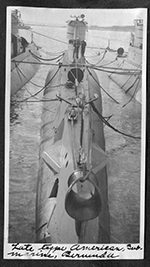 |
1.04k | Late type American submarine, Bermuda. One of the unknown 10 O-boats 1 / 10 (SS-62 / 71) . | Photo by James W. Anderson, courtesy of Kristina Magill via Gary Priolo. | |
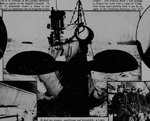 |
659k | A steel sea monster, amphibious and formidable, is Uncle Sam's newest submarine just home from war duty. The great fin rudders stabilize the boat under water and assist in speedy submerging. They fold up snugly against the sides when the "sub." is under way. Several of these new O-boats are making their initial New York appearance in the Naval Review. | Image provided by: Library of Congress, Washington, DC. Photo from the New-York Tribune. (New York [N.Y.]) 1866-1924, 27 April 1919, Image 47, via chroniclingamerica.loc.gov. |
|
 |
85k | Submarine Division 8,Commander Guy E. Davis commanding. Nine of the Division's ten O-boats at the Boston Navy Yard, Charlestown, Massachusetts, 16 August 1921. Panoramic photograph by Crosby, "Naval Photographer", 11 Portland Street, Boston. Submarines in the front row are (from left to right): O-3 (SS-64), O-6 (SS-67), O-9 (SS-70) and O-1 (SS-62). Those in the second row are (from left to right): O-7 (SS-68), unidentified (either O-2 or O-8), O-5 (SS-66), O-10 (SS-71) and O-4 (SS-65). Large four-stacked ship in the left center distance is the U.S. Army Transport Mount Vernon. | USNHC photograph # NH 103193. | |
 |
800k | GERMAN MOTHER OF U.S, SUBS The Saxonia, (now Savannah (AS-8)) once considered the finest German passenger ship, is now a mother for United States submarines. Here she is off the coast at Provincetown, Mass., with some of her cubs. |
Image and text provided by Arizona State Library, Archives and Public Records; Phoenix, AZ. Photo from the Bisbee Daily Review. (Bisbee, Ariz.) 1901-1971, 21 August 1921, SECOND SECTION, Image 9, via chroniclingamerica.loc.gov. |
|
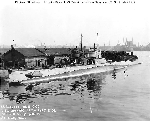 |
83k | O-10 (SS-71) looking aft, port side, outboard of the O-4 (SS-65) at the Boston Navy Yard, 28 September, 1922. Note the big insulating fitting at the bow, which terminates the forward radio loop antenna. Note that O-4's 3"/23 gun is in the extended (operating) position, while that on O-10 is retracted. Four-funneled ship in the right distance is the former U.S. Army Transport Mount Vernon. | Partial text courtesy of U.S. Submarines Through 1945, An Illustrated Design History by Norman Friedman. Naval Institute Press. USN photo # NH 44548, & partial text courtesy of the USNHC. | |
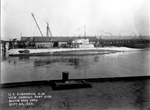 |
130k | Port side view of the O-10 (SS-71) taken at the Boston Navy Yard on 28 September 1922. The submarine is tied up outboard of O-4 (SS-65) and a covered lighter at Pier 10. | Boston Navy Yard photo # 13813-3 Boston, National Historical Park Collection, NPS Cat. No. BOSTS-13813. Photo courtesy of Stephen P. Carlson, Preservation Specialist, Boston NHP, Charlestown Navy Yard. | |
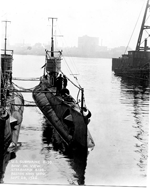 |
105k | Bow on view, starboard side of the O-10 (SS-71) taken at the Boston Navy Yard on 28 September 1922. The submarine is tied up outboard of O-4 (SS-65) and a covered lighter at Pier 10. | Boston Navy Yard photo # 13813-4 Boston, National Historical Park Collection, NPS Cat. No. BOSTS-13813. Photo courtesy of Stephen P. Carlson, Preservation Specialist, Boston NHP, Charlestown Navy Yard. | |
 |
561k | S-10 (SS-115) & S-15 (SS-120) in the foreground. Behind them from right to left: O-1 (SS-62), O-4 (SS-65), O-2 (SS-63) & O-3 (SS-64). What appears to be another conning tower is behind the O-3. If so, and being that all the O-boats are together numerically, it might be the O-5 (SS-66), which would date the photo no later than 28 October 1923 when the O-5 sank after being rammed while entering Limon Bay, Canal Zone, 28 October 1923, by United Fruit steamer Abangarez. |
Photo by Arkivi/Getty Images via Getty Images, courtesy of gettyimages.com. | |
 |
125k | O-4 (SS-65), underway, probably on the Thames River at New London CT., photographed during the 1920s. | USN photo courtesy of ussubvetsofwwii.org. | |
 0806917 | 484k | 3 O-boats bows: Broadside view of O-8 (SS-69) with two other unidentified O-boats moored to a buoy in Gatun Lake, Panama, approximately 1925. The famous Gatun Dam can be seen in the background, with the hydroelectric power station building on the right. The dam is the centerpiece of the canal, providing water for the 21 mile long lake as well as for the majority of the rest of the canal. It also provides power to operate the locks as well as for the needs of the surrounding population. | Photo i.d. & text courtesy of David Johnston (USN, retired) USN photo thanks to Jim Kurrasch @ Battleship Iowa, Pacific Battleship Center. | |
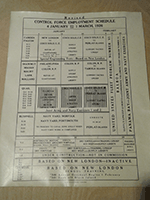 |
1.72k | Control Force Employment Schedule, 4 January to 1 March 1926. US Fleet Problem Number VI. | Photo courtesy of Steve Ireland. | |
 |
174k | The O-4 (SS-65), one of the small undersea craft of the O-Boats series built during WW I, displaced only 480 tons on the surface, less than half of modern subs. Recommissioned in 1930, however, they have proved valuable as training an experimental vessels. Equipped with four torpedo tubes and one anti aircraft machine gun, they can give valuable experience to the new submariners of the U.S. Navy. | Text courtesy of CARD-O chewing gum. Photo courtesy of Tommy Trampp. | |
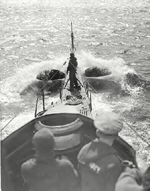 | 263k | Ten photo PDF of on board life on the O-4 (SS-65). | Photo courtesy of Scott Koen & ussnewyork.com. | |
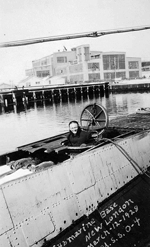 |
94k | Frederick Schmoe, crewman of the O-4 (SS-65), is looking out of the hatch of the boat on 12 March 1928. The boat is moored at the Submarine Base New London, Connecticut. | US Navy and Marine Corps Museum/Naval Aviation Museum, Photo No. 1985.130.013, courtesy of Mike Green. | |
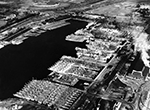 |
2.49k | Philadelphia Navy Yard, 28 October 1940. The photo presented panorama military shipyards in Philadelphia Navy Yard. Most of the ships are obsolete US destroyers, that were transfer to Great Britain under lend lease. The submarines are on the left hand side of the photo, and they are: (in no particular order) The O boats: O-1 (SS-62), O-2 (SS-63), O-3 (SS-64), O-6 (SS-67), O-7 (SS-68), O-8 (SS-69), O-9 (SS-70), O-10 (SS-71). The R boats: R-1 (SS-78), R-2 (SS-79), R-3 (SS-80), R-5 (SS-82), R-6 (SS-83), R-7 (SS-84), R-8 (SS-85), R-9 (SS-86), R-10 (SS-87), R-12 (SS-89), R-15 (SS-92), R-16 (SS-93), R-17 (SS-94), R-18 (SS-95), R-19 (SS-96) & R-20 (SS-97). The S boats: S-11 (SS-116), S-12 (SS-117), S-13 (SS-118), S-14 (SS-119), S-15 (SS-120), S-16 (SS-121), S-17 (SS-122) & S-48 (SS-159). The Olympia (C-6) is shown at the right of the wharf on Broad Street. The stadium in the upper left, was John F. Kennedy Stadium (formally Philadelphia Municipal Stadium) that stood from 1926 to 1992. It was erected for the 1926 Sesquicentennial. |
Photo i.d. courtesy of Ron Reeves (of blessed memory). Photo courtesy of flickr.com. Lower resolution photo. (548k) |
|
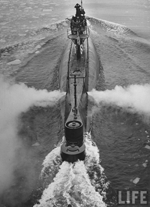 |
386k | O-4 (SS-65) roaring through the ocean off New London, CT, in 1942. | Photographer: Dimitri Kessel, courtesy of time.com. via & Life. | |
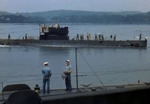 |
189k | A scene from the 1943 movie Crash Dive, showing an unidentified O-class submarine backing out of a berth at the Naval Submarine Base New London, CT in the late summer of 1942. The boat can not be positively identified, but is one of group of eight O-class submarines that were brought out of mothballs to train submarine crews. This particular boat is either O-2 (SS-63),O-3 (SS-64), O-4 (SS-65), O-7 (SS-68), O-8 (SS-69), or O-10 (SS-71). The submarine in the foreground is the Marlin (SS-205). | Photo & text courtesy of David Johnston | |
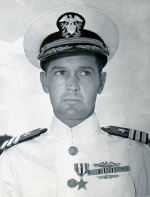 |
10k | Keats Edmund Montross, Commander (Commanding Officer) of the O-4 (SS-65), from 31 May 1942 - 31 Aug 1943. He would be KIA as CO of Swordfish (SS-193), sunk on 13th patrol off Okinawa in January 1945, victim of unknown causes, all 89 hands lost. | USN photo courtesy of oneternalpatrol.com. | |
| Back To The Main Photo Index | Back To the Submarine Index |
|
This page is created by Gary Priolo and maintained by Michael Mohl All Pages © 1996 - 2025 NavSource History |